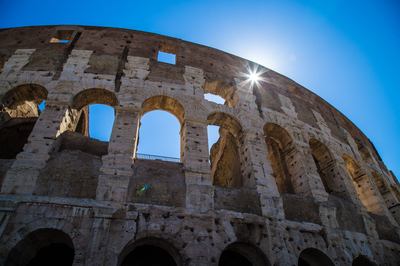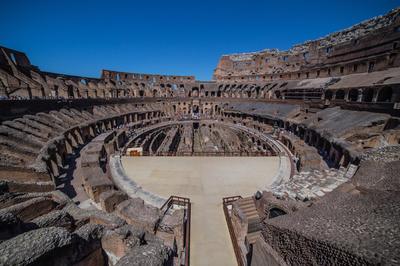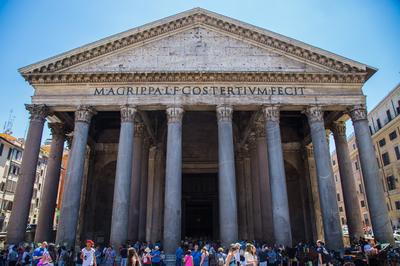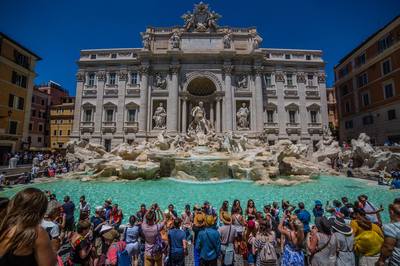|
There is a paradox that faces all travelers. I believe there is a general yearning for an authentic experience that all who travel crave. The catch being that an authentic experience is reserved for those living where travelers are only visitors. There is another issue that faces well traveled locales. Is it possible for authenticity to remain when the main source of economic revenue is tourism? Perhaps places like Cabo or Cancun remain authentically tourist destinations, but for places like Rome, Paris, Venice and other popular cities whatever culture that existed prior has been wiped out almost entirely by tourism. Street after street of unique boutiques and cafes are replaced by storefronts pushing crap merchandise, tourist trinkets, and restaurants selling ‘authentic’ food. It begs another question, is a hamburger made in the heart of Rome authentically Roman on the basis that it is created in Rome and is thereby Roman? These are the questions in my mind as we road a tour bus through the ancient streets of Rome past the Temple of Hercules the Victor and paused momentarily in front of the Vittoriano while honking cabs tried to edge past. We exited the bus at the Flavian Amphitheater as our tour guide told us, or as we knew it, the Colosseum. Forty-five minutes in line and we were in, being pressured along around the rim, pausing for a photo here and there before the pressure of more sightseers nudged us along. It was here at the Colosseum I noticed a new weapon of the tourist. Where the gladiators had battled with sword and shield for valor and honor, or simply death, these tourists battled for a better view, a cleaner angle above the heads of the throng with quite possibly the most upsetting invention I have ever witnessed: the selfie stick.
As an amateur photographer I had dim wittedly opted to lug my mammoth DSLR on my trip, knowing full well the resolution would not be appreciated in the cell phone era. As I jockeyed for a clean shot of the ancient stadium I was vanquished by selfie stick after selfie stick creeping into my otherwise clean view. I don’t mean to let the tourism of the Colosseum hinder possible travelers, of course I was nothing more than a tourist myself, a part of the mob, another foreigner snapping away photos no one would ever see for the soul reason of proving that I was there. I was in awe of the structure, of the history, of the gruesome battles that had taken place. I only wished I could have spent a full day with a historian learning about every secret and structural accomplishment instead of the one hour we were allotted. Perhaps the next time I’m in Rome. After the Colosseum we re-boarded the bus. We were shepherded to the next pre-arranged location, the Piazza del Popolo. The Flamino Obelisk rose from the square, the light still gleaming from it’s worn stone. From here we were suggested three options, three roads laid in front of us. To the right the Via del Babuino which led to the Piazza di Spagna where we would find the Spanish Steps. To the left the Via Ripetta skirted the River Tiber on it’s way to the Pantheon. In the middle the Via del Corso struck directly down the middle of one of Rome’s consumer districts. It also was the fastest route to the Fontana di Trevi, or the Trevi Fountain. With our limited time we decided on seeing the Fountain and then the Pantheon. Apparently the Spanish Steps were under construction and so wouldn’t make for the most compelling selfies. So we made steps down Via del Corso, first in search of food, and then the Fountain. The street was beautiful, cliffs of ancient architecture rising around us. Side alleys cut into the structures like slot canyons. From the first floor up you could imagine that you were in ancient Rome or Rome of the 1920s. From the first floor down you were distinctly in the 21st century. Gucci’s and Dolce & Gabbana’s loudly pronounced sales in their windows with all the modern fashions. Restaurant hosts pressured us as we passed by to try their food, promising cheap deliciousness. The menus read the same four dishes of piadinas, paninis, pizza, and gelato. We picked one at random, I had a caprese panini and water. It was ok. Fed and hydrated we progressed on down Via del Corso past more fashionable stores and chic restaurants. Signs labeled Trevi Fountain ushered us left down a bustling alley until we came into an open square stuffed with people. Cutting through the crowd we got to the fountain’s edge. Alluring blue water lapped gently at the lip of the pool. Every bit of real estate on the edge of the pool was taken by selfie takers and photo models. Above the smiling faces, selfie sticks, and outstretched phone wielding arms towered the statues. The statue in the center represented Ocean, often mistaken for Neptune. The travertine carved robe flowed around him spilling into lower statues, the main source of the fountain arose from his feet. Completed in 1732 the Trevi Fountain is breathtaking in it’s beauty. Can you blame all these day-tripping sightseers for ogling over the artistry? The statues in classic Renaissance Roman form were flowing, mid motion, juxtaposed against the strong features of the Palazzo Poli, whose pillars and square shape form the perfect framing. True to Trevi Fountain tradition we each threw a coin from our right hand over our left shoulder into the pool. One coin is said to guarantee that you will come to Rome again. Two coins and you will be married. Three coins? You will be divorced. Think how much you could save on lawyer fees and alimony. I snapped a few photos of the scene and it wasn’t long until I was handed cameras and cell phones by strangers and who politely requested I take their photo. I suppose carrying around a big ass DSLR credits you as being a pro. I obliged although perhaps I should have charged, might have paid for that night’s imbibements. We left the fountain, swimming through the crowd until we could walk freely side by side. Passing a limoncello shop we glimpsed a sign reading ‘free limoncello shots.’ When in Rome. I can’t say I particularly enjoy limoncello, it’s a bit too sweet, but free booze is free booze. Sampling a few varieties we left the clerk promising to return with the intent to purchase. She knew we were only there for the free shots. Weather it was the limoncello or the unmarked roads getting to the Pantheon took a bit longer than anticipated. A question to a clerk, “dove è il Pantheon,” was met with, in English, “up two blocks and make a left.” Reminding us that we weren’t really in Italy, but in a tourist destination where quite possibly English was more spoken than Italian. Again we wandered through chasms cut into buildings until it opened into another piazza. The Pantheon stood, dominating the scene. Build in 128 AD it was astonishing to see the condition it was still in. The stone was aged and gray, the only sign of age for an otherwise immaculate structure. Entering the Pantheon took no time at all, no ticket required and we moved as fast as the queue moved and we were in. Looking up a sun beam cut through the dusty air illuminating a portion of statues lining the interior. I was simply awestruck to be in a building that old, that beautiful. The architecture, the statues, the light, the shadows. I wanted to sit and watch the sun move through the dome’s hole across the floor. I forgot all about the tourists bustling around me. Selfie sticks couldn’t block my view of the dome. I walked slowly forward, head cocked back, eyes to the sky until I ran into a little girl and her mother. Across the piazza from the Pantheon we found a restaurant selling gelato out of a side window and we each ordered a scoop and ate it in the shade, still unsure how to process something so ancient. Again I found myself longing to be a historian or architect with unbridled access to explore the building, to learn it’s secrets, to spend days and weeks pouring over this one structure instead of the mere ten or so minutes we had been inside. As with the Colosseum, perhaps another time, perhaps another life. Looking at my watch I saw we had fifteen minutes to make our return trip to the Piazza del Popolo and reboard the bus. Fifteen minutes should be plenty of time, but the streets of Rome have a way of scooping up absent minded tourists and leading them into the maze, the minotaur in the labyrinth. If time had been available I would have gladly opted for this option, but it wasn’t, so I didn’t. We took a left and a right and a left again until we came to Via Ripetta, one of the three streets leading back to the Piazza del Popolo. My companions questioned my direction but the towering obelisk at the end of the street was more than enough to go by. We made it in time to be ferried along to our final destination in Rome, the Vatican. We crossed the River Tiber, exited the bus and headed toward the Vatican. It was massive. Saint Peter’s Square sprawled out in front of the ornate Basilica. Perhaps we were exhausted from the day, or the more secular in our group didn’t want to pay to enter, or perhaps we had too many exposed shoulders and knees but we decided not to enter the Basilica. There was an area in Saint Peter’s Square open to the public for photos and more selfies that we took full advantage of before backtracking and turning down a side street. There was a decent looking restaurant there and we decided to have a sit and a drink, our limoncello buzz had almost diminished. I ordered a bottle of wine, some ordered mojitos, some were content with a good old Coca-Cola. Here we sat, drinking and conversing for the entire remainder of our allotted time at the Vatican. And here we quite possibly had the most authentic experience. Do Roman’s visit the sights? Do they take selfies? I didn’t know, I didn’t care anymore. I was content to drink my red blend and have a shot of limoncello. Rome felt like a theme park. An ancient Rome themed Disneyland caricature of itself. The authentic Roman experience is not to be found at the Colosseum, or the Pantheon, or the Vatican. It likely exists in some side street outside of the old town where Italian men smoke, the women cook, and the twenty-somethings plan trips to Paris to take selfies. Rome is still beautiful. If you commit to being a tourist you will see amazing sights. Ancient structures, winding roads, and quite possibly one of the most beautiful cities I’ve ever been. Authentic or not, it’s worth a trip.
0 Comments
Leave a Reply. |
AuthorWilliam Hager Archives
July 2020
Categories |




 RSS Feed
RSS Feed
